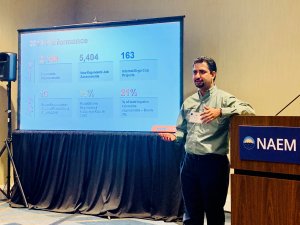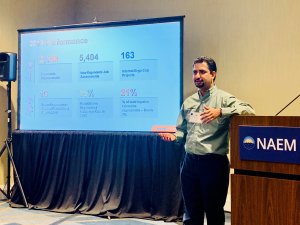Our Conferences are Canceled – Now What?
04/14/2020

When I reached out to Rahul Nair, Health, Safety and Environment IT Strategy Leader at Cummins, to prepare for his session, “Powering Up Data Management – How Innovative Technologies Drives and Sustains the Ergonomics Process at Cummins” at the NAEM Software, Innovation, & Technology Showcase in March, little did I know a global pandemic was about to be declared. He didn’t either.
 Rumors of conference attendees being instructed by their organizations to immediately return home began to circulate before the first keynote address. But it wasn’t a rumor. It was real. People were literally walking off the plane, just to walk back on. Since then, conferences scheduled in March, April, and May have all been canceled.
Rumors of conference attendees being instructed by their organizations to immediately return home began to circulate before the first keynote address. But it wasn’t a rumor. It was real. People were literally walking off the plane, just to walk back on. Since then, conferences scheduled in March, April, and May have all been canceled.
As the Senior Events Manager at VelocityEHS, I want to give you something back. In the next few weeks, I hope to take your mind off the coronavirus for just a second and offer some key learnings and best practices from our experts and customers. Since Nair’s presentation was held in the afternoon of the last day of the NAEM conference and during the onset of COVID-19, it was lightly attended. Read the summary below.
The Cummins Ergonomics Success Story
Established in 1919, Cummins, Inc., a global technology leader, designs, manufactures, distributes, and services a broad portfolio of power solutions. The company’s products range from diesel and natural gas engines to hybrid and electric platforms and related technologies. With 62,600 employees worldwide, Cummins serves customers in approximately 190 countries.
In 2019, the company’s leading and lagging ergonomics metrics proved why the FTSE4Good Index Series, a series of benchmark and tradable indexes for Environmental, Social and Governance (ESG) investors, recognized Cummins for demonstrating strong ESG practices in both 2018 and 2019.
Leading metrics for 2019 include:
- 5,404 ergonomics job assessments completed
- 2,106 improvements implemented
- 163 internal Ergo Cup projects completed
Lagging metrics for 2019 include:
- 19 fewer ergonomics-related recordables compared to 2018
- 15% reduction in musculoskeletal injury (MSD) incidence rate in 2019
- MSDs accounted for 21% of all recordable injuries, down 7%
Employees have worked hard to achieve these metrics. In 2013, after discovering that 28% of total injuries were musculoskeletal-related, and 60% of those were ranked between medium to high risk, EHS leaders sought out an ergonomics management system to reduce workplace injuries and improve workplace health and safety. “Management needed to see numbers and data. It’s how to secure funding,” said Nair. In 2014, Cummins subscribed to Humantech® Industrial Ergonomics software as a service, and the company’s continuous improvement process continues today.
Rahul attributes their success to these three best practices:
1: Enlist a Capable Platform/Partner
In 2014, Cummins partnered with VelocityEHS to roll out Humantech Industrial Ergonomics across 350 global sites. After users completed the six core courses in the online ergonomics training and attended in-person implementation workshops and validators training, ergonomics team members were equipped to complete accurate MSD risk assessments.
2. Identify What Needs to be Improved, Measure It, and Clearly Correlate the Data to Injuries
For completed risk assessments, jobs were scored as either high (red), medium (yellow), or low (green) risk. From this data, team members could use the Job Assessment Summary report to get a prioritized list of high-risk jobs to fix first. To sustain the process, an annual reduction goal using the Risk Reduction Index report target could be set. Over a one-year period, dynamic charts displayed monthly risk reduction metrics and how much the risk priority points were reduced after each improvement. The future trend, encompassing all risk priority score point reductions, additions, and the reduction targets, predicts if the company’s improvement process is on track or falling behind.
3. Gain Leadership Support
Demonstrating the value of ergonomics to management is absolutely necessary for long-term success.
Rahul suggests:
- get stakeholder buy in across all levels of the organization.
- demonstrate value beyond just injury reduction, and assign an executive sponsor to push your requests, needs, and successes (in the form of reports) to the stakeholders
- hold people accountable—it gives them ownership (assign accountability to operation leaders instead of HSE leaders alone).
An ergonomics process is ongoing. Offering additional training (webinars and feedback sessions), holding business review meetings with VelocityEHS customer success specialists, attending conferences and meetings to be kept abreast of product updates and trends in the industry, and scheduling post-implementation check-ins are all things Cummins does to stay ahead of the curve. To reduce the job improvement process from hours to minutes, the company is also piloting the software’s Advanced Assessment Tool that uses artificial intelligence and computer vision at two of its locations.
Summing It All Up
By 2019, Cummins had completed more than 20,000 active job assessments and a total of 4,000 improvements have been made; with 2,000 being implemented in 2019 alone! The Ergonomics Incidence Rate (EIR) has dropped from .154 in 2017 to .127 in 2019.






